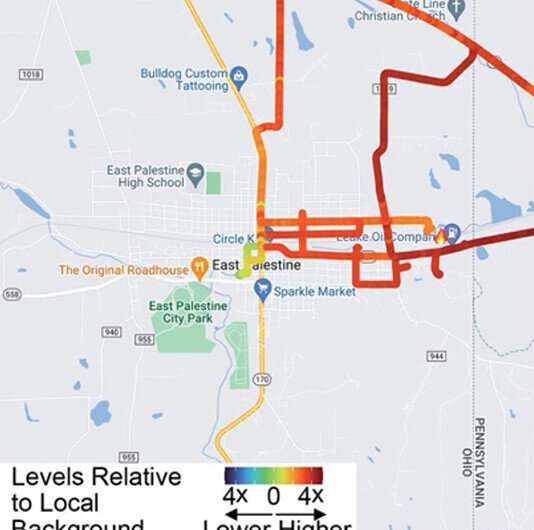This article has been reviewed according to Science X's editorial process and policies. Editors have highlighted the following attributes while ensuring the content's credibility:
fact-checked
peer-reviewed publication
trusted source
proofread
Ohio train derailment, clean-up resulted in high levels of some gases, study shows

A freight train carrying industrial chemicals derailed near East Palestine, Ohio, in February 2023, and to avoid explosions, authorities conducted a controlled release and burned the cars' contents. Residents were worried about their health and the environment, so researchers have been assessing the local air quality with stationary and mobile sampling methods. Now, in ACS' Environmental Science & Technology Letters, they report that some gases, including acrolein, reached levels that could be hazardous.
After the derailment, disaster response teams emptied and burned the cargo. Because the tanker cars carried many volatile compounds, such as vinyl chloride and butyl acrylate, localized air-quality-related evacuation orders were issued. However, after returning to their homes, some residents reported symptoms similar to those that typically result from exposure to hazardous levels of airborne compounds. So, Albert Presto and colleagues wanted to monitor air quality and identify the potential health risks in and around East Palestine.
The researchers downloaded air-quality monitoring data from two U.S. Environmental Protection Agency (EPA) stations at fixed locations. And to map patterns of airborne compounds, they drove a cargo van around the area for two days in late February. Inside the van was a mass spectrometer, which was used to identify a wide array of gases, upwind and downwind of the accident site. Then the team calculated the health risks for the gases that were above average or background levels.
From the EPA data, the team determined that the levels of nine of the 50 gases initially rose above their normal baselines, especially acrolein, a respiratory irritant. If these nine compounds remained at those levels, the ambient air could pose health risks, say the researchers. Yet, through February, the amounts of many pollutants decreased significantly. In fact, vinyl chloride declined to concentrations below long-term limits of health concern. Mobile monitoring detected changes over time and space that the stations could not. For instance, during the day, acrolein and butyl acrylate were up to six times higher near the accident site than background levels, but at night they dropped to the background amount. These results indicate the importance of complementary stationary and mobile air-quality assessment techniques, the researchers say, and both should continue as cleanup activities proceed.
More information: Oladayo Oladeji et al, Air Pollutant Patterns and Human Health Risk following the East Palestine, Ohio, Train Derailment, Environmental Science & Technology Letters (2023). DOI: 10.1021/acs.estlett.3c00324
Journal information: Environmental Science & Technology Letters
Provided by American Chemical Society





















